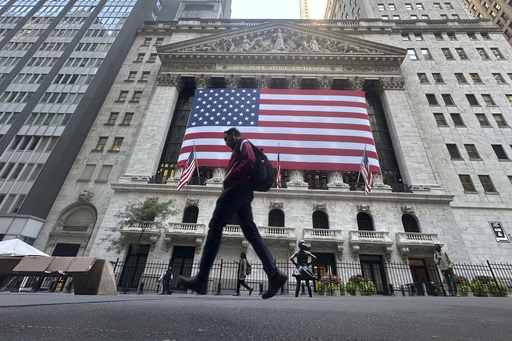U.S. stocks reached all-time highs on Friday, fueled by a surge from major banks following a series of encouraging profit announcements.
The S&P 500 rose by 0.6%, surpassing its previous record high from earlier in the week, marking its fifth consecutive week of gains. Meanwhile, the Dow Jones Industrial Average climbed by 409 points, or 1%, achieving a record as well. The Nasdaq composite lagged behind with a more modest increase of 0.3%, hindered by a decline in Tesla’s shares.
Wells Fargo experienced a notable 5.6% increase after posting quarterly profits that exceeded analysts’ expectations, due in part to improved results from its venture-capital investments and higher fees in investment banking services.
Typically, banks lead the way at the start of each earnings season, and JPMorgan Chase saw a rise of 4.4% after reporting a smaller decline in profits than anticipated. This performance significantly contributed to the upward movement of the S&P 500. CEO Jamie Dimon noted that the country’s largest bank continues its stock buyback program, although at a slower pace given that current market values appear somewhat inflated.
BlackRock also saw gains, rising by 3.6% after delivering better-than-expected quarterly profits. By the end of September, the investment firm managed a record total of $11.5 trillion in assets for its clients.
The impressive performance by banks offset the drag from Tesla, which fell 8.8%, making it a substantial negative influence on the overall market. The automaker recently introduced its much-anticipated robotaxi, but critics pointed out a lack of detailed information regarding its rollout plans.
Uber Technologies, a potential competitor, saw its shares soar by 10.8%, contributing positively to the S&P 500, while Lyft shares increased by 9.6%.
In summary, the S&P 500 gained 34.98 points, closing at 5,815.03, the Dow rose by 409.74 points to 42,863.86, and the Nasdaq composite increased by 60.89 points, finishing at 18,342.94.
Additionally, Stellantis saw a 2.8% decline in its European shares after announcing significant leadership changes, including the timing of CEO Carlos Tavares’ retirement. The company’s chief financial officer is also leaving amidst challenges in revitalizing sales in North America, following the merger of PSA Peugeot and Fiat Chrysler.
In the bond market, Treasury yields showed mixed results in response to recent inflation updates and consumer sentiment data. In September, producer prices rose by 1.8% compared to the previous year, reflecting an improvement since August but falling short of economists’ expectations. This eased concerns that were highlighted in an earlier report about consumer-level inflation not decreasing at the anticipated rate.
Another report indicated that consumer sentiment in the U.S. was weaker than expected, though the decline fell within a margin of error, as per Joanne Hsu, director of the University of Michigan’s Surveys of Consumers.
Following these reports, traders adjusted their forecasts, anticipating that the Federal Reserve would lower its primary interest rate by a quarter percentage point at its next meeting, according to data from CME Group.
Expectations have diminished since earlier this month when some speculated on a more significant half percentage-point cut in November; recent positive economic data has affected these predictions. Nonetheless, the long-term trend for interest rates continues to lean downward, as noted by Solita Marcelli, chief investment officer for the Americas at UBS Global Wealth Management, which could potentially uplift stock prices overall.
Last month, the Federal Reserve reduced its main interest rate from a two-decade peak, shifting its focus toward sustaining economic growth rather than solely combating inflation.
The yield on the 10-year Treasury increased to 4.09% from 4.07%, while the two-year yield, which more closely correlates with expectations of the Fed’s next moves, slightly declined to 3.95% from 3.96%.
Globally, stock markets saw a 2.5% drop in Shanghai, reflecting volatility ahead of a briefing by China’s Finance Ministry, where investors hope for the announcement of a significant stimulus plan for the world’s second-largest economy.
In South Korea, the Kospi index dipped by 0.1% after the central bank implemented its first interest rate cut in over four years to stimulate the economy.
This website uses cookies so that we can provide you with the best user experience possible. Cookie information is stored in your browser and performs functions such as recognising you when you return to our website and helping our team to understand which sections of the website you find most interesting and useful.
